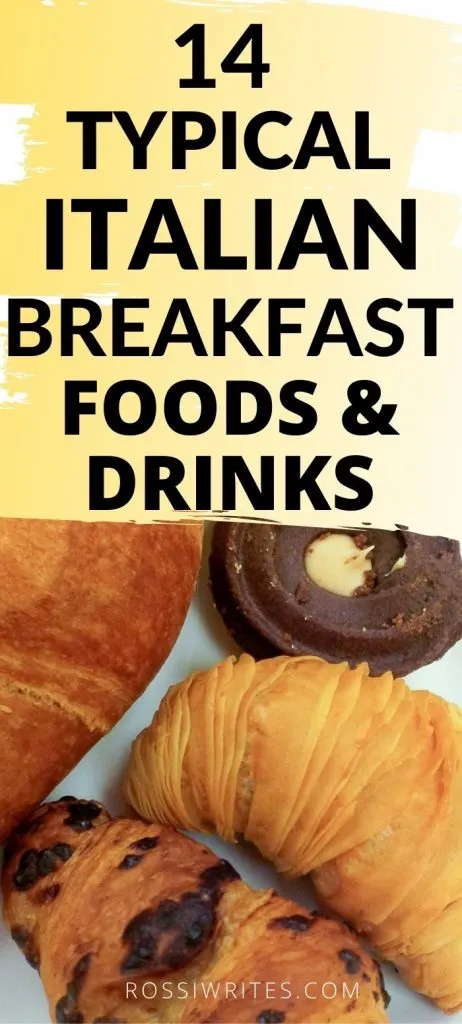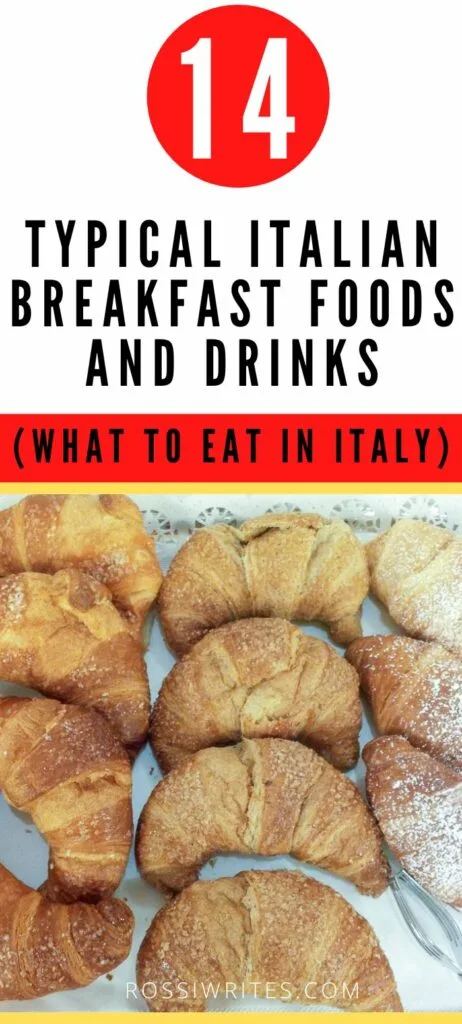If you are wondering what do Italians eat for breakfast, here is a useful list of ten typical Italian breakfast foods and four typical Italian breakfast drinks.
You will find them on the breakfast table in Italy in any season.
The traditional Italian breakfast – or colazione in Italian – is a small and sweet affair. Often, it simply consists of a cup of coffee and a couple of biscuits or a cappuccino and a cornetto (also called brioche in Northern Italy). The latter is a croissant-shaped Italian pastry that is served either:
- plain or vuoto in Italian which literally means ’empty’; or
- with a delicious filling like chocolate spread, jam, creme patisserie (or crema pasticcera in Italian), and even pistachio cream.
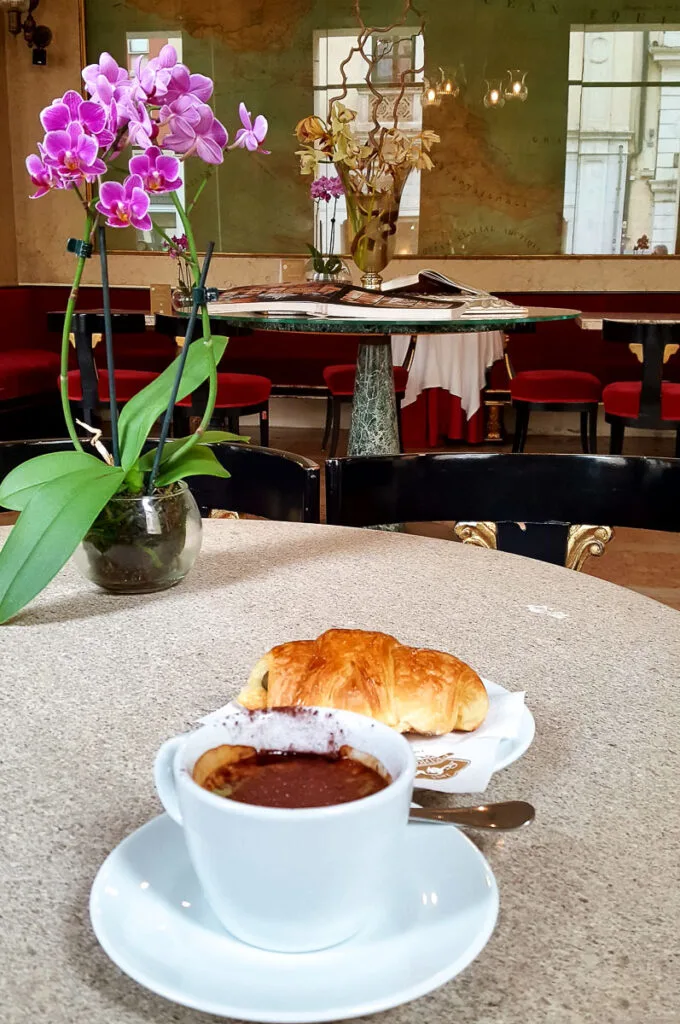
There are many historical, social, and culinary reasons that have shaped the Italian breakfast. I have covered them in detail in my blog post:
Click on it and read it for a detailed overview of the Italian breakfast traditions.
In this blog post instead, I want to introduce you to the ten most common Italian breakfast foods and four most popular Italian breakfast drinks. You will typically find them served for breakfast in Italian homes, Italian eateries, and Italian hotels.
Knowing what they are and why they are considered perfectly acceptable breakfast fodder in Italy, will help you enjoy in the best possible way the first meal of the day during your Italian holiday.
Have a look!
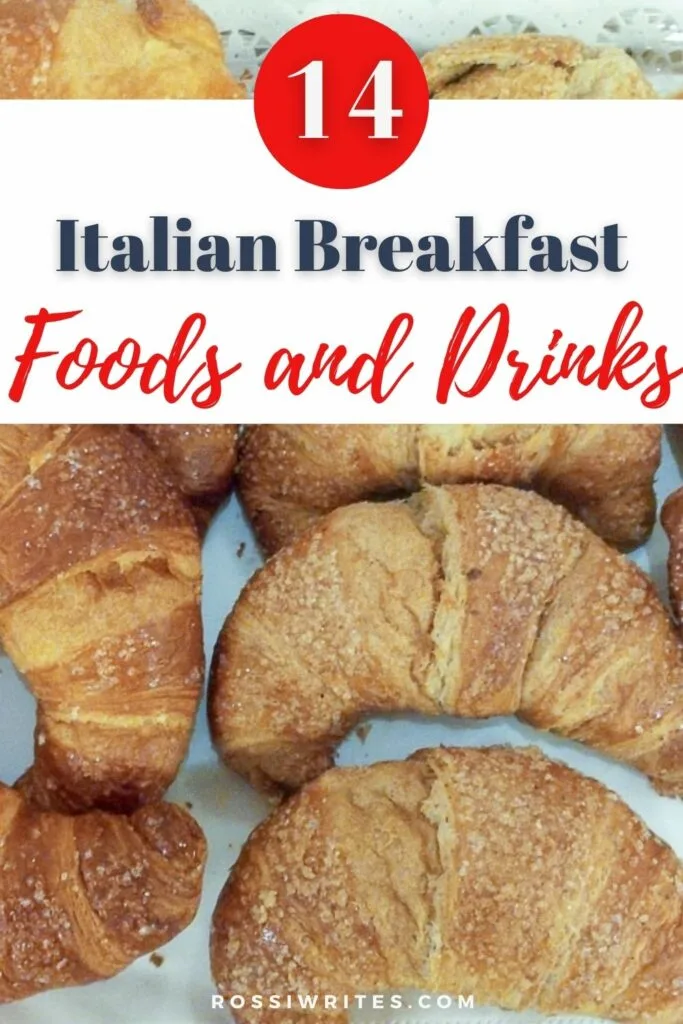
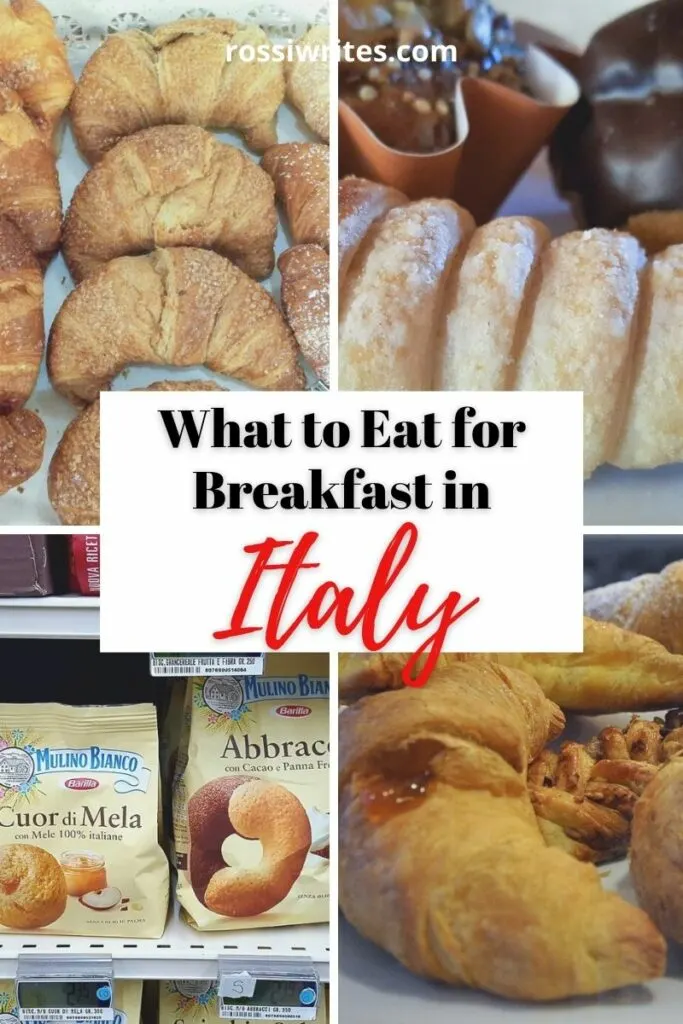
10 Typical Italian Breakfast Foods or What Do Italians Eat for Breakfast
1. Biscotti (Biscuits)
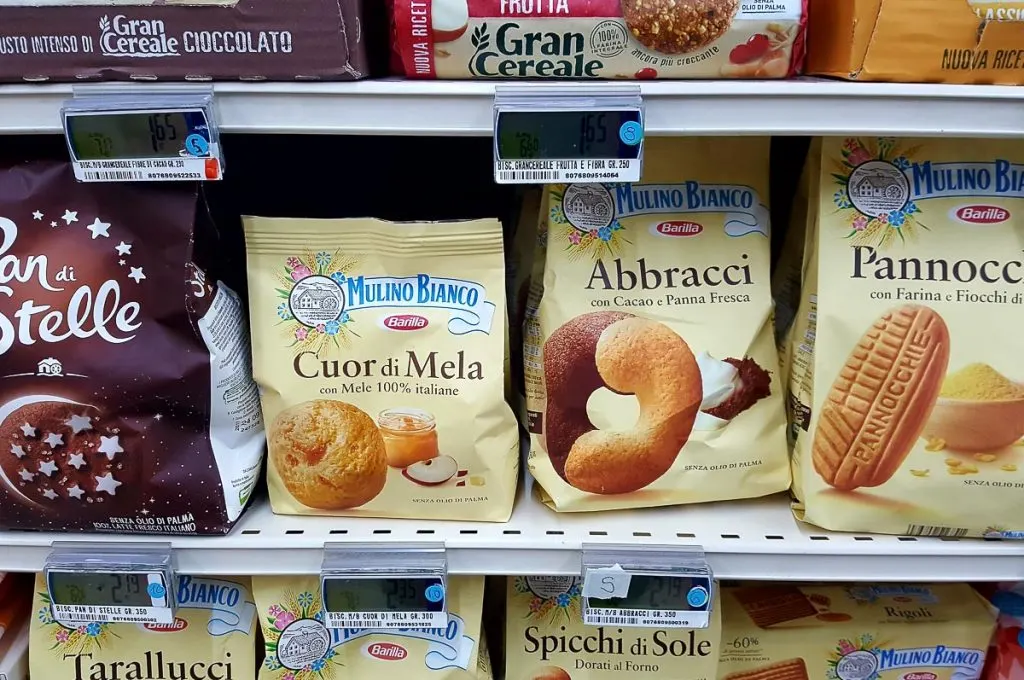
Biscuits are the most popular Italian breakfast food!
According to a poll on the breakfast habits of the Italians conducted in 2019 by YouGov Italia, 57% of all Italians eat biscotti first thing in the morning. This is a habit that started back in the 1960s. Up until that moment, dry bread dipped in milk had been a staple of Italian breakfasts.
With the industrial advances of Italy and specifically, the Italian Economic Miracle between 1958 and 1963, eating dry bread for breakfast suddenly had too many connotations of poverty. Hence, biscuits quickly gained a footing as a flour-based yet richer and sweeter breakfast alternative.
Italy’s breakfast biscuits are known as frollini. These are shortcrust-based biscuits made of flour, butter, sugar, and eggs. Nowadays, there are many dozens of biscuit varieties sold in Italy. They are pressed in different shapes and have names to match.
For example, a circular biscuit with cacao- and cream-flavoured halves is called Abbracci which in English translates as ‘hugs’. You can see it in the photo above. I took it in my local shop in Italy when I used to live in a small city called Vicenza there.
Abbracci (as well as many other types of Italian breakfast biscuits) are sold on Amazon, so it’s easy to order them from abroad if you want to have a taste.
The most important producer of Italian breakfast biscuits is Mulino Bianco. You will see their large bags of biscuits sold in all Italian supermarkets and delis.
Pan de Stelle is one of the most popular brands of breakfast biscuits in Italy. Whole generations of Italian kids have grown up eating these dense cacao biscuits dotted with tiny white stars.
While eating biscuits for breakfast may sound quite wonderful, bear in mind that the Italians are very strict about portion control. Hence, traditionally, they only have a couple of biscuits for breakfast. Definitely, not the whole pack!
You will also notice that the biscuits that are made in Italy tend to be somewhat drier and less sweet than biscuits sold in England, for example. They are perfect to dip in coffee or milk.
My Verdict on This Italian Breakfast Food: While I could never fully embrace a breakfast of two biscuits and a cup of coffee during my six years of living in Italy, I did develop an appreciation for Italian biscotti. My favourite brands are Nascondini (which are like little flat tubes filled with chocolate) and Cuor di Mela (which are stuffed with apple jam). Pan di Stelle, Abbracci, and Ritornelli are also quite nice.
2. Cornetto / Brioche (A Croissant-Shaped Italian Breakfast Pastry)
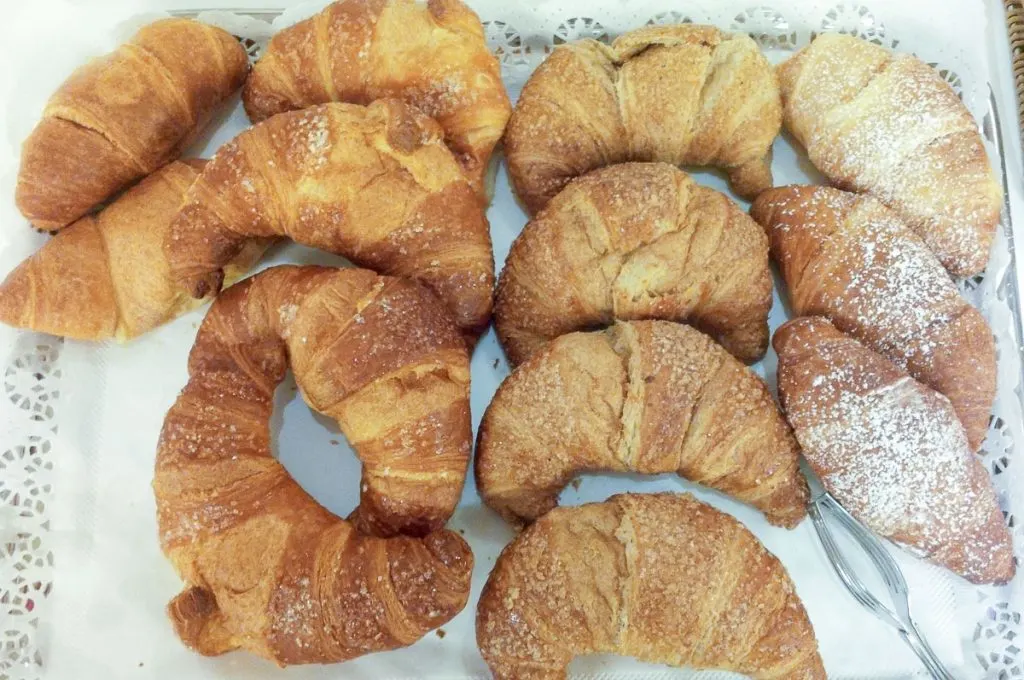
Cornetto is the most widely available breakfast food in Italy when you eat breakfast outside of the house. This is a breakfast pastry that is freshly baked in Italian bakeries and patisseries each morning. In Northern Italy, it’s known as brioche, and as I lived in the Northern Italian city of Vicenza, this is the name I came to know it and love it under.
A brioche is a croissant-shaped pastry. Unlike a croissant though, it’s quite big in size, it’s much less flaky, it can be made of different types of flour (from white to wholemeal), and it’s sold either plain (vuoto) or stuffed with many different fillings. You will see piles of freshly-baked brioches sold in every self-respecting Italian bar, bakery, and patisserie every morning.
Grabbing a cup of cappuccino or espresso with a brioche is one of the true delights of the Italian dolce vita.
Brioches are filled after having been baked. You will notice that on top of each brioche there is a small blob of filling. This is to help you identify the type of filling inside. Some of the most popular brioche fillings are: chocolate spread, crema pasticcera (known as creme patisserie in English), jam, and pistachio cream.
They say that brioches were inspired by the Viennese kipferl – a crescent-shaped pastry that is also the croissant’s grandfather.
My Verdict on This Italian Breakfast Food: I truly and fully fell in love with brioche during my time in Italy. There is nothing better than to grab a cup of coffee and a brioche with either crema pasticcera or pistachio cream first thing in the morning. Often, patisseries in Italy will also sell mini brioches. If you are new to Italian breakfast and its traditional pastries, then you can buy a couple of mini brioches with different fillings and see which one you like the most.
My heartfelt advice is to steer clear of factory-produced packaged brioches. They have little to do with the real thing which is freshly made and baked each morning on-site in the Italian bakeries and patisseries.
3. Fette Biscottate (Rusks)
Rusks are another popular food for breakfast in Italy.
They are small thin slices of bread that have been baked a couple of times to achieve their very dry texture and lovely dark caramel colour. Which explains their name as fette biscottate in Italian means precisely ‘twice-baked slices’.
You will find them sold in all Italian supermarkets and also provided as a breakfast option in Italian hotels and B&B’s. They are usually packaged in two’s or four’s and can be bought in a large pack of several individual-size packages.
Italian rusks are very hard, so they are great for dipping.
My Verdict on This Italian Breakfast Food: While there is something very satisfying in nibbling them, I must admit that the fette biscottate are my least favourite traditional Italian breakfast food. I find them a bit boring to the point where I never got compelled to take a photo of them (while I have dozens of photos of brioches and other Italian breakfast pastries).
4. Pane, Burro e Marmellata (Bread, Butter, and Jam)
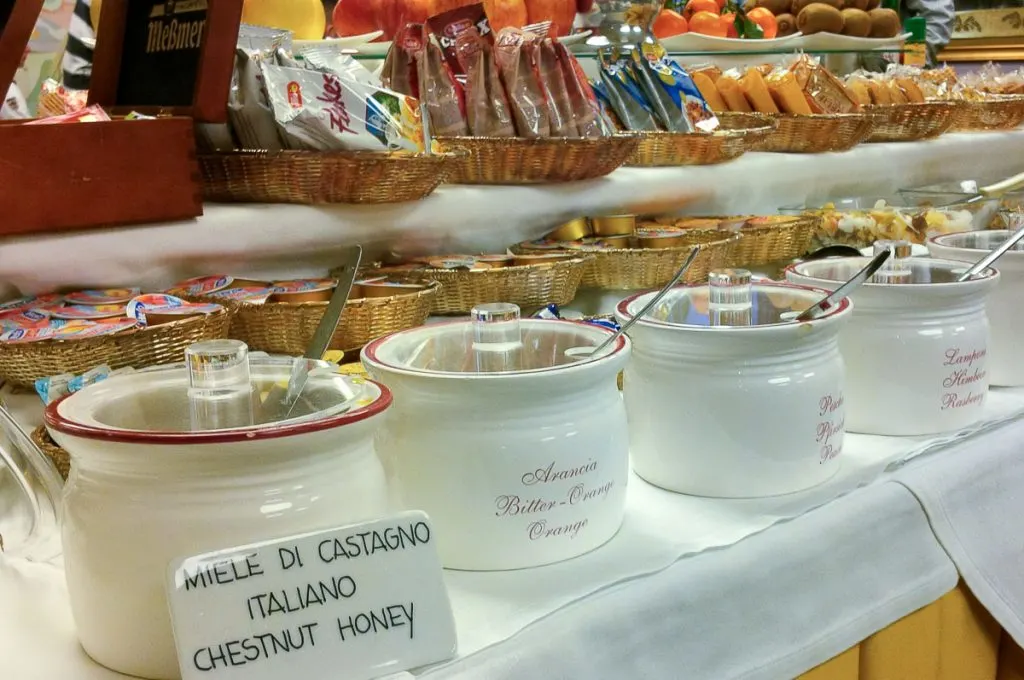
A fresh bread roll from the local bakery with a bit of butter and a scraping of jam on top is traditional breakfast in Italy. Often, Italians jazz it up by using a nice chocolate spread instead. Or honey!
There are many different types of bread sold here. Just head to the nearest small bakery and buy a few different rolls and loaves and then get on sampling.
In general, I never saw salted butter sold in Italy. And there are dozens of different jams and honey here. As for the chocolate spread, Nutella is the most well-known one. However there are dozens of other chocolate spreads here, so, don’t limit yourself. The choice is excellent! Some of the most well-known brands are Venchi, Caffarel, and Rigoni di Asiago (my favourite!).
Rigoni di Asiago also has a selection of delicious kinds of honey which were another staple of my breakfasts in Italy.
So, while bread, butter, and jam/spread/honey doesn’t sound like a groundbreaking breakfast option, it’s quite nice to have it in Italy. Most Italian hotels offer several varieties of bread rolls and jams/spread/honey at their breakfast tables. So, you can experiment and see which one you like the most.
My Verdict on This Italian Breakfast Food: I loved the variety of bread, jams, spreads, and honey in Italy. Two of my favourite types of bread here were:
- pane mantovano (which, in a way, looks like the puffy pages of a book stuck together); and
- rolls studded with sunflower seeds (my local bakery made these with cornflour so they were pale yellow in colour and so very tasty).
Italian jams and honey are delicious. I fell in love with the chestnut honey which is dark in colour and very more-ish.
With regards to spreads, take it up a notch and give pistachio cream a try. It is truly scrumptious!
5. Crostata e Torta (Pies and Cakes)
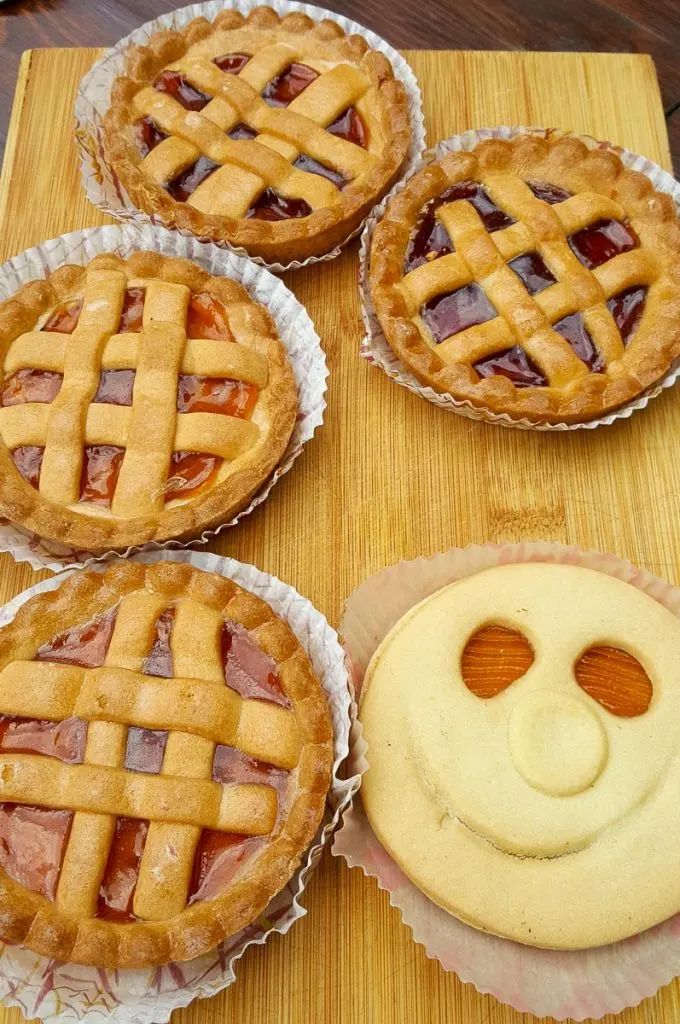
Yes, it’s true! The Italians eat pies and cakes for breakfast!
A fact that I first became aware of a decade ago during a long weekend break in Florence. Before flying there from England, I had seen several mentions online of the torta della nonna (literally, Grandma’s Cake) – each stating how good it is. So, I really wanted to try it.
One evening, after a nice dinner and a long walk around the beautiful historic centre of Florence, we popped into a bar just off Piazza della Signoria. A bar in Italy is a great place for it not only sells alcoholic drinks but it’s also where you head for coffee, a light bite to eat, and even breakfast.
Anyway, I was in luck as this bar had some slices of torta della nonna! It being after dinner, I thought it was the perfect time to have a slice. That’s it until the barista told me: ‘Oh, it’s a very rich cake! I usually have it for breakfast!’
His statement was a bit of a shock for me but later on, when we actually moved to Italy and lived there for six years, I came to realise that the barista wasn’t joking.
It’s perfectly fine in Italy to start the day with a small slice of cake. Official data actually states that 19% of Italians have cake for breakfast every now and then! Again, their portion control is tight, so slices are small, cakes are thin and quite dry and/or fruit-based.
A crostata is another cake-like breakfast food in Italy. It’s shaped like a pie for it has a shortcrust pastry base and strips of pastry crisscrossed on its top. The filling is usually jam or chocolate. You can buy mini crostate – one for each person – or a large crostata and then eat it slice by slice over several breakfasts.
My Verdict on This Italian Breakfast Food: I love a small piece of Italian cake for breakfast! I am undecided about crostata. All in all, it’s not bad but it can be really dry and crumbly. So, it depends!
6. Other Italian Breakfast Pastries
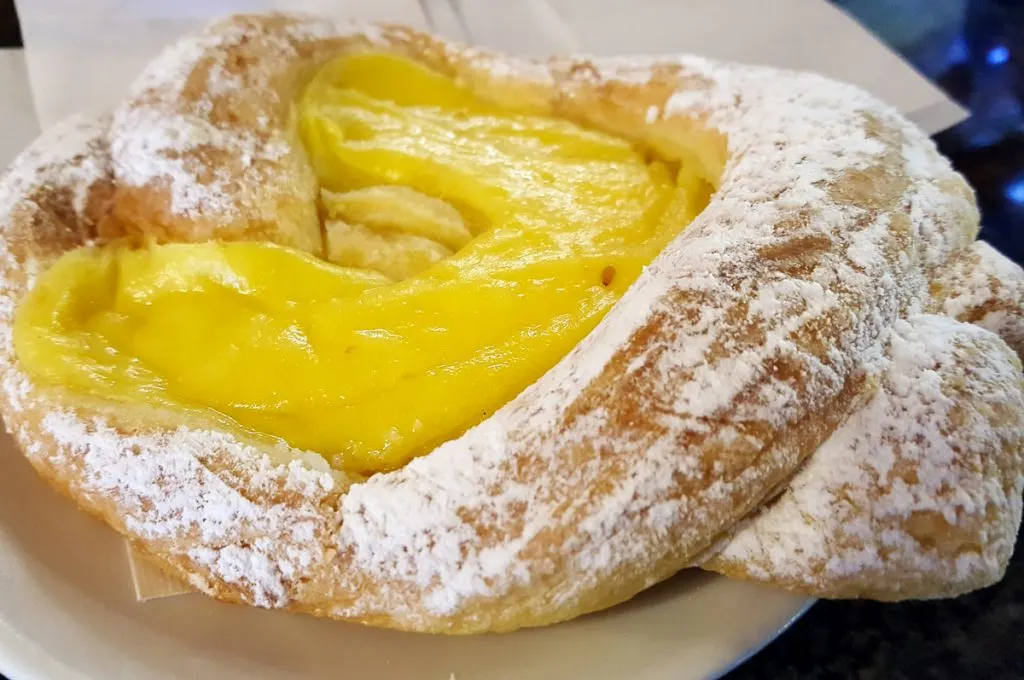
While cornetto/brioche rules as the most popular breakfast pastry in Italy, there are other varieties of pastries here to tuck into first thing in the morning.
More or less, every Italian patisserie you go to will have a large selection of freshly-baked pastries on display. Just make sure that you head there early as they do start selling out by mid-morning.
The patisserie around the corner where I lived in Vicenza made these little parcels of puff pastry with a rich filling of raisins. They were called fagottini and were delicious. There were also these spiral-shaped pastries – girelle – with creme patisserie and raisins which were lip-smacking good.
Not forgetting the wonderful fluffy doughnuts with a variety of fillings – from jam and chocolate spread to creme patisserie and pistachio cream. Known both as ciambelle and krapfen, they are really good. Don’t miss a chance to treat yourself to one for breakfast in Italy!
And I remember coming across this beauty of a pastry that is pictured just above. It was shaped like a ribbon and filled with a generous helping of crema cotta. It’s a good thing I immediately had it for breakfast that day in a small patisserie in Verona as I never saw it again anywhere else.
My Verdict on This Italian Breakfast Food: Experiment! Never let an opportunity pass you to sample yet another Italian breakfast pastry. There are so many different varieties that breakfast in Italy can easily become a delicious tasting session.
7. Cereali (Cereals)
There is a good variety of cereals and muesli sold in Italy. Their popularity has been growing since the 1980s when they first appeared on the Italian breakfast table. Nowadays 30% of Italians eat cereals regularly for breakfast.
Looking at the boxes of cereals and muesli in the Italian supermarkets, my impression was that the emphasis was on healthier options. Think fibre, nuts, and dried fruits as opposite to sugary and highly-processed brands.
Italian hotels usually offer a good selection of cereals and muesli for breakfast, too.
My Verdict on This Italian Breakfast Food: I am not too keen on cereals and muesli. We kept buying a box every now and then only to push it to the back of the cupboard where it languished for months. There is a nice selection of cereal and muesli bars in Italian supermarkets though. I preferred those, especially as they made for easy snacks to take with us when we went travelling and hiking around Italy.
8. Yogurt (Yoghurt)
A small pot of yoghurt nowadays is considered a typical Italian breakfast option. Starting in the 1980s, yoghurt and cereals became an alternative to the beloved by all Italians breakfast biscuits and pastries.
Yoghurts in Italy are usually very tasty. The local supermarkets stock a wide selection of yoghurt flavours and brands. There are both full-fat (yogurt intero) and fat-free (yogurt magro) options.
I was particularly fond of the Sterzing Vipiteno and the Latterie Vicentine yoghurt brands. We even went to this festival organised by Latterie Vicentine where we joined a guided tour of their yoghurt-making factory and could sample all the different varieties of yoghurts they make there. It was a great day!
You can expect to find all the traditional yoghurt flavours like strawberry, apricot, and forest fruits in Italian supermarkets and hotels. In addition, there are several yoghurt flavours sold here that are typical for Italy. For example, hazelnut, orange, pistachio, and even coffee!
My Verdict on This Italian Breakfast Food: I loved Italian yoghurts. I especially loved the availability of so many full-fat yoghurt flavours. Now that I am living in England, yoghurts here seem to be predominantly fat-free and it’s just not the same. I was really fond of the hazelnut, pistachio, and coffee yoghurts in Italy. Give them a try!
9. Frutta (Fruit)
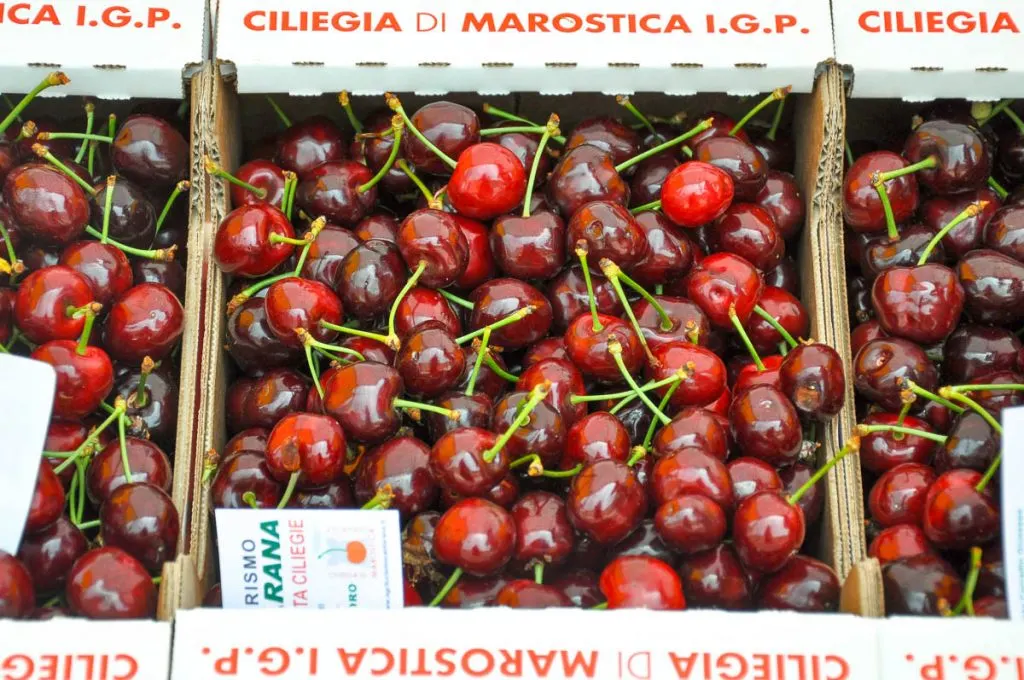
Fruit is often eaten as part of Italian breakfasts. Italy has very well-developed agriculture and fresh, seasonal fruit is very easy to buy and savour at its best. Apples from Trentino, kiwis and peaches from Lake Garda, cherries from Marostica, citrus fruit from Sicily, many local varieties of fruit… You will be spoiled for choice!
Head to the local market or greengrocer to pick some juicy beauties for your breakfast in Italy. Italian supermarkets also stock fruit and veg that are mainly locally grown, so you have many options to buy freshly picked seasonal produce.
If your hotel serves breakfast, most often than not, there is a good selection of fruit offered to guests. Forego the imported bananas and try what’s local and fresh.
My Verdict on This Italian Breakfast Food: What can I say?! Eating fresh seasonal fruit was one of the advantages of living in Italy. Just by looking at the selection in our local fruit and veg shop, I knew not just what season it was but also the month. Juicy clementines for Christmas, sweet grapes in August, apples from Trentino year-round. All the fresh, juicy fruit was a wonderful addition to our Italian breakfast table.
10. Regional and Seasonal Italian Breakfast Foods
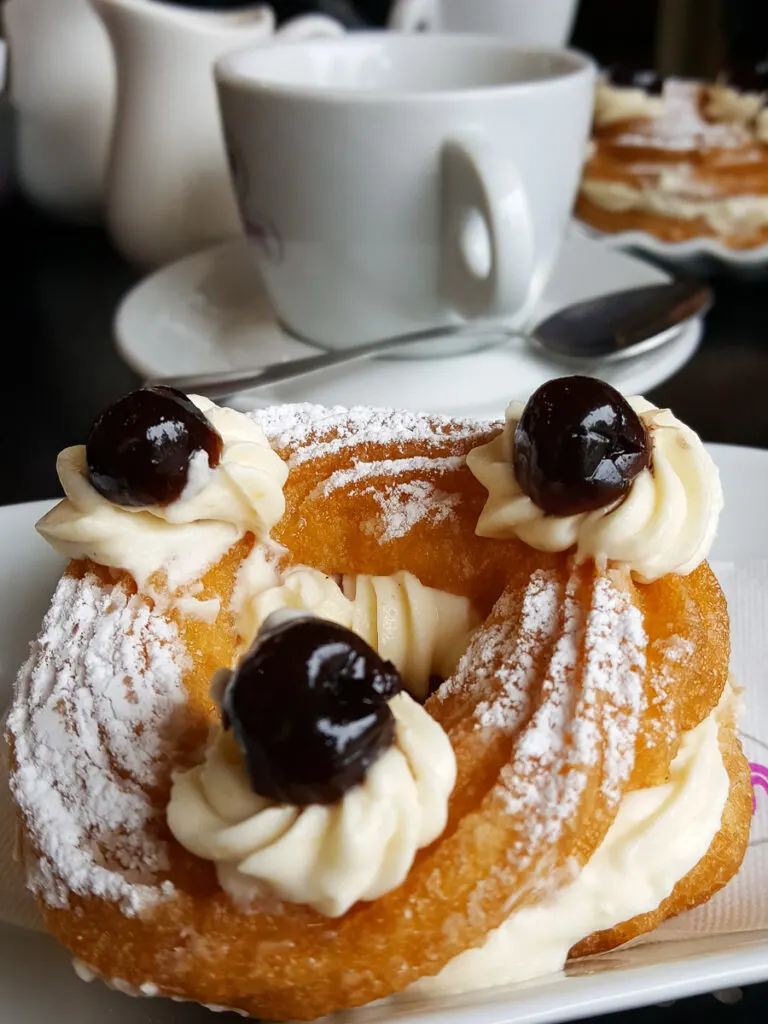
While nowadays most Italians start the day with a breakfast of biscuits or a cornetto/brioche, the different Italian regions have preserved some local breakfast specialities, too. For example, maritozzi – sweet buns stuffed with whipped cream – which are typical for Rome.
The change of seasons and the string of Italian holidays also have several different pastries and sweet loaves associated with them. Panettone and pandoro for Christmas, frittelle for Carnival, zeppole di San Giuseppe for Father’s Day, and colomba for Easter add seasonal excitement to Italy’s breakfast menu.
My Verdict on This Italian Breakfast Food: I really loved discovering regional varieties of Italian breakfast foods. And I was always happy to add a seasonal sweet loaf or dessert to my breakfast table in Italy. It was a great way to feel in synch with the change of seasons. It also added to the excitement of the different holiday periods.
4 Typical Italian Breakfast Drinks or What Do Italians Drink for Breakfast
1. Caffè (Coffee)
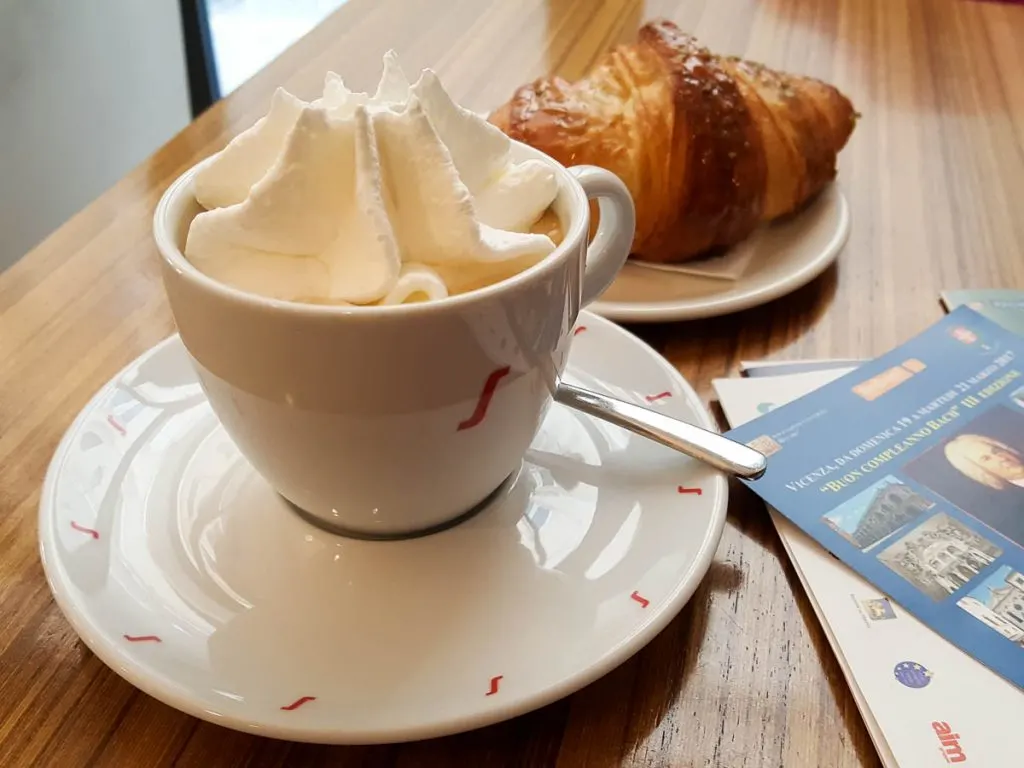
Coffee truly is the king of breakfast in Italy.
Breakfast at the bar or the local patisserie unfailingly includes a cup of coffee. This can be either cappuccino, macchiato, macchiatone or – for those that don’t drink milk like me – a strong espresso.
Bear in mind that coffee in Italy is served in much smaller cups compared to the drink sizes used by multinational coffee chains. At the same time, coffee here is of excellent quality and it gives you a nice buzz in the morning.
At home, the Italians start the day by putting their trusty Moka pot on the stove. A Moka (also sometimes called Moka Express) is a traditional coffee pot invented and patented by Alfonso Bialetti in 1933. Millions of Italians use a Moka to prepare a cup of strong, fragrant coffee for their breakfast at home every day. The pot consists of two parts and a small filter for the coffee grounds.
It’s very easy to use and it makes great coffee. My husband gave me a Moka pot for our anniversary when we still lived in Italy.
At the start, I would only use it on weekends when we had more time in the morning. Very quickly though, the Moka became a huge part of our mornings. Since we returned to England a year and a half ago, we haven’t started a day without a Moka-made cup of coffee. It adds Italian flair to our English breakfasts.
Nowadays, Moka pots are sold all over the world. If you are interested in getting one for yourself, have a look at the selection currently available on Amazon.
My Verdict on This Italian Breakfast Drink: I love coffee in Italy and Italian coffee. It’s a wonderful experience to have a cup of espresso in an Italian bar just watching the world go by.
I loved drinking coffee in Italy and I also loved dipping in its history and traditions. Click on the links below for a wealth of information about the Italian coffee culture. There are some truly curious facts there for you to discover:
- Coffee in Italy or 101 Facts About Italian Coffee Culture
- 19 Rules of Italian Coffee Culture or How to Drink Coffee Like an Italian
- 21 Types of Italian Coffees and How to Order Coffee in Italy Like a Local
- 3 Cold Coffee-Based Drinks for Your Hot Italian Summer
2. Latte (Milk)
Milk has been a traditional presence on the Italian breakfast table for many decades if not centuries.
As late as the 1950s, Italian kids would breakfast on pieces of stale bread dipped in milk. This simple breakfast meal was known as zuppa di latte or milk soup.
Nowadays, Italian kids dip in a glass of milk their breakfast biscuits instead. And the adults often add milk to their morning coffee, too.
My Verdict on This Italian Breakfast Drink: I don’t drink milk but don’t let this stop you. I don’t have a dairy intolerance (as I love cheese, yoghurt, and ice cream). There is simply something in the smell of milk that really puts me off it. So, unfortunately, I can’t report first-hand on Italian milk (only on Italian dairy products). Do give it a try for yourself and let me know what you think.
3. Spremuta e Succo di Frutta (Fruit Juice)
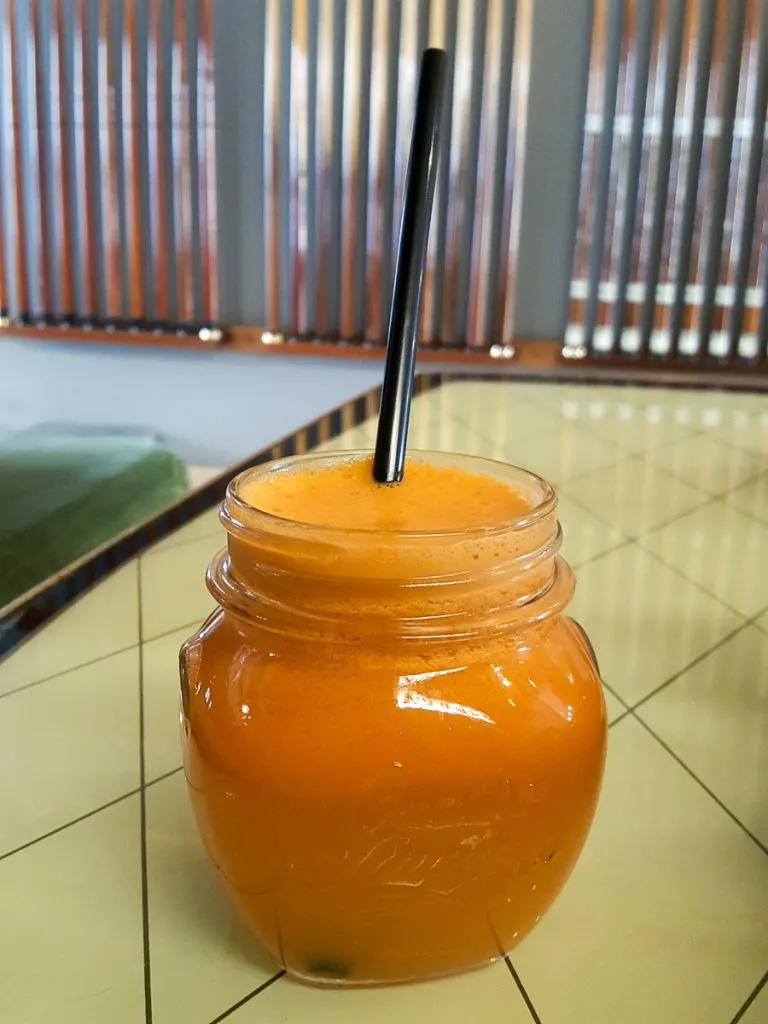
Freshly squeezed fruit juices and fruit juices from a box are a popular complement to the typical Italian breakfast. You will find a big selection of fruit juices sold in every Italian supermarket. At the same time, Italian bars and patisseries are traditionally equipped with a juicing machine and are thus able to serve freshly squeezed juices (called spremuta), too.
Bear in mind that while a large juice box from the shop will cost only a euro or two, a small glass of juice (both freshly squeezed and from a box) at the bar or the patisserie will set you back anything from 3 euros upwards.
My Verdict on This Italian Breakfast Drink: With Italy’s abundance of fresh seasonal fruit, it certainly is very nice to have a glass of freshly squeezed juice with your Italian breakfast.
4. Tè e Tisana (Tea and Infusions)
Tea and infusions are the least popular breakfast drinks in Italy.
A nice Italian hotel will offer a large selection of black, scented, and herbal teas for breakfast. You can usually find a good choice of teas and infusions in a nice Italian patisserie, too. In a bar?! Not so much!
Plus, for some reason, both tea and infusions are rather costly to order in Italy. A small cup of tea/infusion can cost anything from 2.50 to 4 euros. This is quite unpalatable considering that an excellent espresso is usually only around a euro per cup.
My Verdict on This Italian Breakfast Drink: I did become used to good tea during my years in England, so when we moved to Italy I did miss English tea a bit. For some reason, I could never find tea in Italy that was as strong as the one sold in England. Tea was the one thing that we actually brought with us from England after each visit to my husband’s family there.
I did enjoy a nice infusion every now and then though. There are some truly delicious infusion mixes and flavours offered in Italian patisseries. Still, I found their price quite excessive for the small size cup you would get and soon I switched completely to coffee during our six years in Italy.
In Conclusion
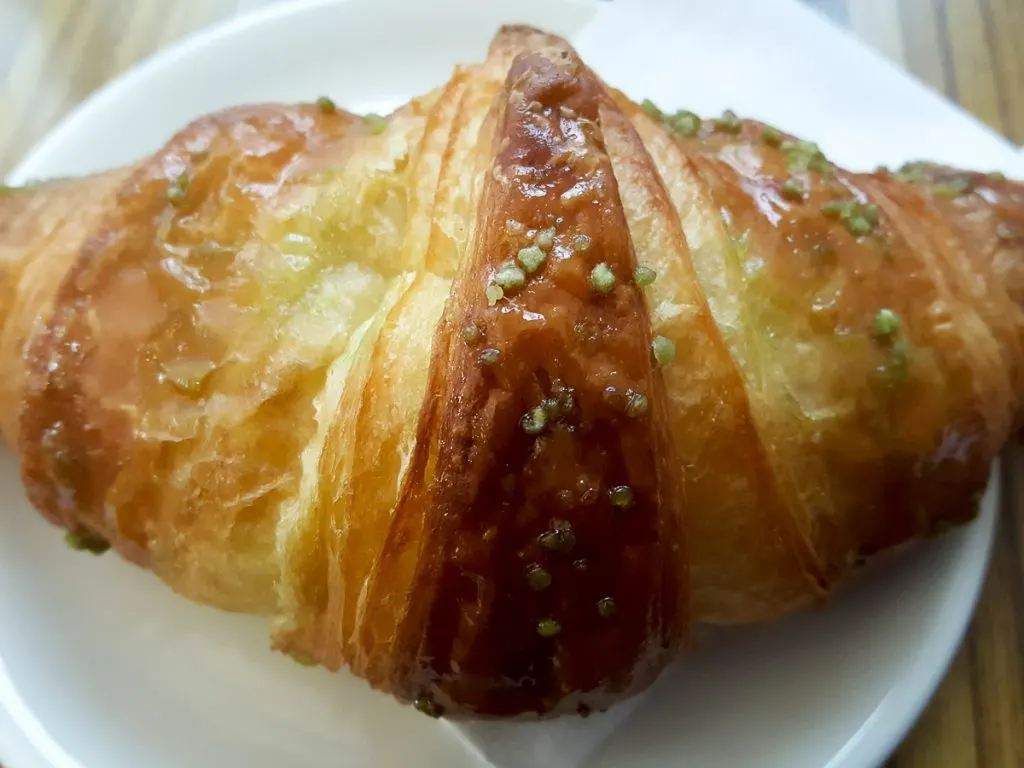
A traditional Italian breakfast is a small and sweet affair that is eaten quickly, almost on the go. Its main components are biscuits, pastries, milk, and coffee.
Many first-time visitors to Italy are taken by surprise by the Italian approach to breakfast. It certainly can come as a bit of a shock to be served a small pastry with coffee if you are used to treating yourself to a large fried meal first thing in the morning.
To help you navigate the Italian breakfast table and to understand the reasons that have come to shape it, in the above blog post I have listed for you ten typical Italian breakfast foods and four typical Italian breakfast drinks. The information is based on both my research into the breakfast habits of the Italians, official poll data, and my personal experience of eating a daily Italian breakfast during my six years of living in Northern Italy.
I hope that you will find the information and the curious facts shared herewith of use and that they will inspire you to tuck into your own Italian breakfast as soon as possible.
Enjoy breakfast in Italy!
More Helpful Info for You about Food in Italy
Food in Italy: Rules of Italian Breakfast, Best Italian Food Gifts, Cheap Food in Italy, Italian Cheeses, Traditions of Panettone, What is Polenta, Caperberries, Mandorlato Veneto, Venetian Fritella, Sant’Antonio Cakes, Making Prosciutto, Arrosticini, Tortellini, Cremino
Food Festivals in Italy: Chestnut Festivals, Truffle Festival, Cherry Festivals, Pea Festival, Prosciutto Festival, Chocolate Festival
Coffee in Italy: Italian Coffee Culture, Cold Coffee Drinks, 101 Facts About Coffee, 21 Italian Coffee Drinks
Markets in Italy: Rialto Fish Market, Padua Market, Types of Markets
More Helpful Italy Info for You
Best of Italy: Italy Gift Guide, Italian Piazzas
Northern Italy: 10 Reasons to Visit, 18 Best Cities to Visit, Major Airports
Lake Garda: Best Towns, Nearest Airports, Travel Options, Lake Garda with Kids
Lake Como: Things to See, Nesso
Veneto: Best Cities to Visit, Top 15 Places, 30 Adventures, 15 Most Colourful Places
Friuli Venezia Giulia: Venzone, Most Beautiful Villages
Emilia Romagna: Bologna, Ravenna, Comacchio, Most Beautiful Villages
Marche: 6 Reasons to Visit, Gradara, Frasassi Caves, Temple of Valadier
Trentino: Cities and Towns in Trentino, Rovereto, Lakes in Trentino, Lake Caldonazzo, 15 Amazing Places
Venice: Essential Tips, Major Landmarks, Hidden Gems, How to Navigate Venice, Venice in a Day for Art Lovers, Train Stations, Nearest Airports, Best Tours, Boats in Venice, Haunted Venice, Day Trips from Venice, Arco del Paradiso
Verona: Things to Do in One Day, Verona Opera Festival, Day Trips from Verona
Padua: Things to Do in One Day, 101 Facts About Padua, 10 Reasons to Visit Padua, Day Trips from Padua
Vicenza: Things to Do, Best Museums, Day Trips from Vicenza
Day Trips in Italy: Bologna to Verona, Milan to Verona, Venice to Verona, Bologna to Venice, Milan to Venice, Florence to Venice, Verona to Venice, Venice to Padua, Venice to Lake Garda, Milan to Lake Garda, Verona to Lake Garda, Bologna to Lake Garda
